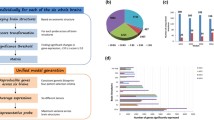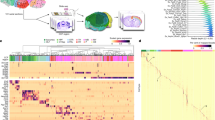Abstract:
Technologies for 3D genome-wide mapping of expression patterns will be increasingly important to understand the brain in health and disease. Here, we describe the use of voxelation to reach these goals. The brain is divided into spatially registered cubes which are subjected to high-throughput expression analysis using methods such as microarrays or real-time PCR. The data can then be used to reconstruct expression images reminiscent of those obtained from biomedical imaging systems. We discuss the insights obtained from voxelation of the mouse brain at a volumetric resolution of 11 μl and 1 μl and the human brain at 1 cm3 and 87 μl. The human and mouse studies also incorporated Alzheimer's and Parkinson's disease specimens, giving a better understanding of the molecular pathology of these disorders. Furthermore, we describe useful analytic approaches to understanding the large datasets resulting from voxelation.
Access this chapter
Tax calculation will be finalised at checkout
Purchases are for personal use only
Similar content being viewed by others
Abbreviations
- Drd2:
-
dopamine D2 receptor
- Nfl:
-
neurofilament light chain
- qRT-PCR:
-
quantitative real time-PCR
- SVD:
-
singular value decomposition
References
Barlow JZ, Huntley GW. 2000. Developmentally regulated expression of thy-1 in structures of the mouse sensory-motor system. J Comp Neurol 421(2): 215–233.
Boguski MS, Jones AR. 2004. Neurogenomics: At the intersection of neurobiology and genome sciences. Nat Neurosci 7(5): 429-433. Website available at: http://www.brainatlas.org/.
Bonner RF, Emmert-Buck M, Cole K, Pohida T, Chuaqui R, et al. 1997. Laser capture microdissection: Molecular analysis of tissue. Science 278(5342): 1481, 1483.
Brown VM, Ossadtchi A, Khan AH, Yee S, Lacan G, et al. 2002. Multiplex three-dimensional brain gene expression mapping in a mouse model of parkinson’s disease. Genome Res 12(6): 868–884.
Bunney WE, Bunney BG, Vawter MP, Tomita H, Li J, et al. 2003. Microarray technology: A review of new strategies to discover candidate vulnerability genes in psychiatric disorders. Am J Psychiatry 160(4): 657–666.
Gambhir SS, Barrio JR, Herschman HR, Phelps ME. 1999. Assays for noninvasive imaging of reporter gene expression. Nucl Med Biol 26(5): 481–490.
GongS, Zheng C, Doughty ML, Losos K, Didkovsky N, et al. 2003. A gene expression atlas of the central nervous system based on bacterial artificial chromosomes. Nature 425(6961): 917–925.
Heintz N. 2001. Bac to the future: The use of bac transgenic mice for neuroscience research. Nat Rev Neurosci 2(12): 861–870.
Hendler RW, Shrager RI. 1994. Deconvolutions based on singular value decomposition and the pseudoinverse: A guide for beginners. J Biochem Biophys Methods 28(1): 1–33.
Herschman HR, MacLaren DC, Iyer M, Namavari M, Bobinski K, et al. 2000. Seeing is believing: Non-invasive, quantitative and repetitive imaging of reporter gene expression in living animals, using positron emission tomography. J Neurosci Res 59(6): 699–705.
Loring JF. 2005. Evolution of microarray analysis. Neurobiol Aging 27(8):1084–1086.
Louie AY, Huber MM, Ahrens ET, Rothbacher U, Moats R, et al. 2000. In vivo visualization of gene expression using magnetic resonance imaging. Nat Biotechnol 18(3): 321–325.
Min N, Joh TH, Kim KS, Peng C, Son JH. 1994. 5′ upstream DNA sequence of the rat tyrosine hydroxylase gene directs high-level and tissue-specific expression to catecholaminergic neurons in the central nervous system of transgenic mice. Brain Res Mol Brain Res 27(2): 281–289.
Missale C, Nash SR, Robinson SW, Jaber M, Caron MG. 1998. Dopamine receptors: From structure to function. Physiol Rev 78(1): 189–225.
Owen MJ, Cardno AG, O’Donovan MC. 2000. Psychiatric genetics: Back to the future. Mol Psychiatry 5(1): 22–31.
Raichle ME. 1998. Behind the scenes of functional brain imaging: A historical and physiological perspective. Proc Natl Acad Sci USA 95(3): 765–772.
Singh RP, Brown VM, Chaudhari A, Khan AH, et al. 2003. High-resolution voxelation mapping of human and rodent brain gene expression. J Neurosci Methods 125(1–2): 93–101.
Stork O, Hashimoto T, Obata K. 1994. Haloperidol activates tyrosine hydroxylase gene-expression in the rat substantia nigra, pars reticulata. Brain Res 633(1–2): 213–222.
Yaworsky PJ, Gardner DP, Kappen C. 1997. Transgenic analyses reveal developmentally regulated neuron- and muscle-specific elements in the murine neurofilament light chain gene promoter. J Biol Chem 272(40): 25112–25120.
Zacharias DA, Baird GS, Tsien RY. 2000. Recent advances in technology for measuring and manipulating cell signals. Curr Opin Neurobiol 10(3): 416–421.
Editor information
Editors and Affiliations
Rights and permissions
Copyright information
© 2009 Springer Science+Business Media, LLC
About this entry
Cite this entry
Chin, M.H., Smith, D.J. (2009). Cubing the Brain: Mapping Expression Patterns Genome-Wide. In: Lajtha, A., Banik, N., Ray, S.K. (eds) Handbook of Neurochemistry and Molecular Neurobiology. Springer, Boston, MA. https://doi.org/10.1007/978-0-387-30375-8_29
Download citation
DOI: https://doi.org/10.1007/978-0-387-30375-8_29
Publisher Name: Springer, Boston, MA
Print ISBN: 978-0-387-30343-7
Online ISBN: 978-0-387-30375-8
eBook Packages: Biomedical and Life SciencesReference Module Biomedical and Life Sciences




